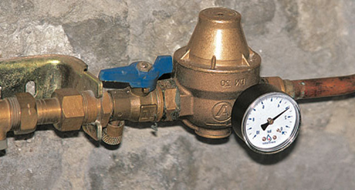Services to Citizens
Water Management
Annual review of the quality of drinking water
Every year, by March 31, the Town of Sutton submits its report on drinking water quality for the period from January 1 to December 31 of the previous year.
As confirmed by its reports, the Town ensures that it meets all ministère de l’Environnement et de la Lutte contre les changements climatiques (MELCC)’s requirements governing drinking water quality. See below for the data on the drinking water distribution systems for the mountain and town sectors, as well as the well of the gushing spring on the road 215.
Mountain sector
Spring on Highway 215
Town sector
Vulnerability Analyses of Drinking Water Sources
Protecting the quality of drinking water is a fundamental measure for all those who produce and distribute it. The Water Withdrawal and Protection Regulation, adopted in July 2014, imposes obligations on those responsible for water withdrawals, including the obligation to conduct a vulnerability analysis of their withdrawal site.
This process allows the person responsible for a surface water or groundwater withdrawal to highlight the weaknesses, problems and threats that affect their drinking water supply. It helps to identify priorities for action to reduce threats or to develop an appropriate contingency plan.
By April 1, 2021, the person responsible for a Class 1 water withdrawal had to have completed the entire process, produced the report, had it signed by a professional and sent it to the various entities involved, including the Ministry. Thereafter, this report must be updated every five years.
A Class 1 water withdrawal serves the distribution system of a municipality and supplies more than 500 people and at least one residence (section 51 of the EPPR).
More information here: https://www.environnement.gouv.qc.ca/eau/prelevements/analyse-vulnerabilite.htm
Flushing of the water mains
Each year, the Town of Sutton must maintain the water mains network by carrying out a one-way flushing, which generally begins in mid-April and ends in July. This process eliminates deposits in the pipes, which ensures the quality of drinking water in the long term and the proper functioning of the infrastructure (hydrants, valves, pipes, valves, etc.). It is important to mention that the flushing is done by sector, which explains why the operations are spread out over several weeks.
The process could temporarily cause cloudy to yellowish water. In this case, simply run the cold water, preferably from your bathtub faucet, until it becomes clear. It is not recommended to wash clothes during this period. The use of bleach during this period may stain clothing.
Sign up for Mass alert and notification system CITAM to receive rinse dates in your area via text message (SMS), email or voice message. Flushing times will also be posted on the Town’s website and Facebook page.
Do you have a pressure reducing valve at home?
Although the water pressure in the water system is controlled, it is not impossible for pressure variations to occur. The purpose of a pressure reducing valve is to reduce the water pressure in your pipes when the pressure from the water system is too high. Too much water pressure can cause damage to your appliances (washing machine, water heater, etc.), as well as premature wear and tear on the pipes in your home.
Please note that, in accordance with our Bylaw 217 on the use of drinking water, the installation of a pressure reducer with a pressure gauge is mandatory for existing homes and new constructions in the mountain sector and, when the pressure at the point of connection is equal to or greater than 525 kPa, for all other homes connected to the water system.

